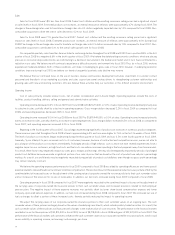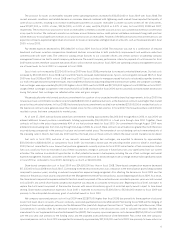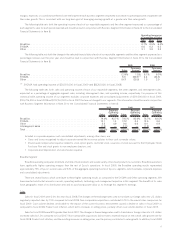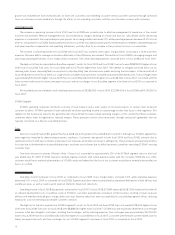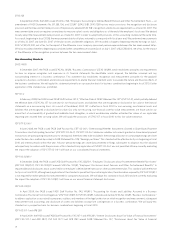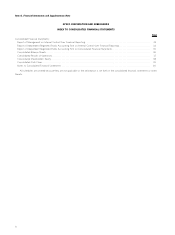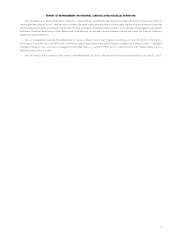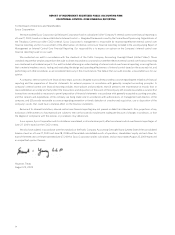Sysco 2009 Annual Report Download - page 44
Download and view the complete annual report
Please find page 44 of the 2009 Sysco annual report below. You can navigate through the pages in the report by either clicking on the pages listed below, or by using the keyword search tool below to find specific information within the annual report.inherently uncertain.We have reviewed with the Audit Committee of the Board of Directors the development and selection of the critical accounting
policies and estimates and this related disclosure. Our most critical accounting policies and estimates pertain to the allowance for doubtful accounts
receivable, self-insurance programs, company-sponsored pension plans, income taxes, vendor consideration, goodwill and intangible assets and
share-based compensation.
Allowance for Doubtful Accounts
We evaluate the collectability of accounts receivable and determine the appropriate reserve for doubtful accounts based on a combination of
factors. We utilize specific criteria to determine uncollectible receivables to be written off, including whether a customer has filed for or has been
placed in bankruptcy, has had accounts referred to outside parties for collection or has had accounts past due over specified periods. Allowances are
recorded for all other receivables based on analysis of historical trends of write-offs and recoveries. In addition, in circumstances where we are aware
of a specific customer’s inability to meet its financial obligation, a specific allowance for doubtful accounts is recorded to reduce the receivable to the
net amount reasonably expected to be collected. Our judgment is required as to the impact of certain of these items and other factors as to ultimate
realization of our accounts receivable. If the financial condition of our customers were to deteriorate, as was the case in fiscal 2009, additional
allowances may be required.
Self-Insurance Program
We maintain a self-insurance program covering portions of workers’ compensation, general liability and vehicle liability costs. The amounts in
excess of the self-insured levels are fully insured by third party insurers. We also maintain a fully self-insured group medical program. Liabilities
associated with these risks are estimated in part by considering historical claims experience, medical cost trends, demographic factors, severity
factors and other actuarial assumptions. Projections of future loss expenses are inherently uncertain because of the random nature of insurance
claims occurrences and could be significantly affected if future occurrences and claims differ from these assumptions and historical trends. In an
attempt to mitigate the risks of workers’ compensation, vehicle and general liability claims, safety procedures and awareness programs have been
implemented.
Company-Sponsored Pension Plans
Amounts related to defined benefit plans recognized in the financial statements are determined on an actuarial basis. Three of the more critical
assumptions in the actuarial calculations are the discount rate for determining the current value of plan benefits, the assumption for the rate of
increase in future compensation levels and the expected rate of return on plan assets.
For guidance in determining the discount rates, we calculate the implied rate of return on a hypothetical portfolio of high-quality fixed-income
investments for which the timing and amount of cash outflows approximates the estimated payouts of the pension plan. The discount rate
assumption is reviewed annually and revised as deemed appropriate. The discount rate for determining fiscal 2009 net pension costs for the
Retirement Plan, which was determined as of the June 28, 2008 measurement date, increased 0.16% to 6.94%. The discount rate for determining
fiscal 2009 net pension costs for the SERP, which was determined as of the June 28, 2008 measurement date, increased 0.39% to 7.03%. The
combined effect of these discount rate changes was a decrease in our net company-sponsored pension costs for all plans for fiscal 2009 by an
estimated $8,692,000. The discount rate for determining fiscal 2010 net pension costs for the Retirement Plan, which was determined as of the
June 27, 2009 measurement date, increased 1.08% to 8.02%. The discount rate for determining fiscal 2010 net pension costs for the SERP, which
was determined as of the June 27, 2009 measurement date, increased 0.11% to 7.14%. The combined effect of these discount rate changes will
decrease our net company-sponsored pension costs for all plans for fiscal 2010 by an estimated $38,600,000. A 1.0% increase in the discount rates
for fiscal 2010 would decrease Sysco’s net company-sponsored pension cost by $34,100,000, while a 1.0% decrease in the discount rates would
increase pension cost by $40,000,000. The impact of a 1.0% increase in the discount rates differs from the impact of a 1.0% decrease in discount
rates because the liabilities are less sensitive to change at higher discount rates. Therefore, a 1.0% increase in the discount rate will not generate the
same magnitude of change as a 1.0% decrease in the discount rate. As of June 27, 2009, our net actuarial losses from our company-sponsored
pension plans were $534,892,000, an increase of $183,688,000. We estimate the amortization of net actuarial losses will increase our fiscal 2010
pension expense by approximately $23,000,000 as compared to fiscal 2009.
We look to actual plan experience in determining the rates of increase in compensation levels. We used a plan specific age-related set of rates
for the Retirement Plan, which are equivalent to a single rate of 5.21% as of June 27, 2009 and 6.17% as of June 28, 2008. For determining the benefit
obligations as of June 27, 2009, the SERP calculations use an age-graded salary growth assumption with reductions taken for determining fiscal
2010 pay due to base salary freezes in effect for fiscal 2010. As of June 28, 2008, the SERP assumes various levels of base salary increase and
decrease for determining pay for fiscal 2009 depending upon the participant’s position with the company and a 7% salary growth assumption for all
participants for fiscal 2010 and thereafter.
The expected long-term rate of return on plan assets of the Retirement Plan was 8.00% for fiscal 2009 and 8.50% for fiscal 2008. In fiscal
2009, the expected long-term rate of return on plan assets assumption was changed to a net return on assets assumption, which contributed to the
0.50% decrease in the assumption to 8.00% in fiscal 2009. Prior to fiscal 2009, this assumption represented gross return on assets, and plan
expenses were reflected within service cost. The expectations of future returns are derived from a mathematical asset model that incorporates
assumptions as to the various asset class returns, reflecting a combination of historical performance analysis and the forward-looking views of the
financial markets regarding the yield on long-term bonds and the historical returns of the major stock markets. Although not determinative of future
24


